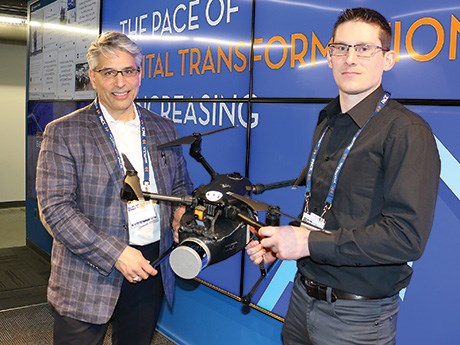Failure is part of the innovation process
This is not your father’s mining industry anymore.
Sons and daughters stepping into dad’s work boots face an entirely different work environment today – one that their fathers and grandfathers probably wouldn’t recognize.
That was evident at the second annual Beyond Digital Transformation conference held in Sudbury February 6 and 7. Organized by change management consultancy PACE Inc. (Partners in Achieving Change Excellence), the conference attracted roughly 200 delegates from mining companies and suppliers.
Robotic mobile equipment, biometrics to measure a miner’s body heat and even the use of small modular reactors to provide low cost energy at remote mine sites were among the ideas on the table.
Just as important, mining leaders spoke of the need to accept innovation and to be open to the idea that failure is normal in the innovation process.
That was a key part of a presentation by a North Bay drone company that is surveying an underground mine in Timmins to provide 3-D mapping accurate to one-sixteenth of an inch.
SafeSight Exploration of North Bay is working at the Goldcorp Hoyle Pond mine to map out the entire mine, including every drift, raise and stope, using a drone equipped with LiDAR (Light Detection and Ranging) technology.
The presentation was delivered by Goldcorp Porcupine Gold Mines’ chief surveyor Dave Poulin and SafeSight president Mike Campigotto.
Poulin said that using the drone was a fast and accurate way of providing an up-to-date version of the mine map that not only shows the layout of every drift, but also records whether there are protruding rock outcrops in the tunnel walls – the sort of thing that might cause a problem for remotely operated trucks or scoops. Low hanging ventilation and cables would also be recorded.
He said it is an innovation that allows areas of the mine to be mapped without sending a survey team into an area of dangerous ground conditions or poor ventilation. The LiDAR survey records 600,000 points a second as the drone moves through a drift.
The system also allows the mine to remotely investigate any ground failures or unsafe areas of the mine to help speed up remediation. Poulin, a former mine rescue volunteer, said in the future, drones equipped with gas sniffers might be used to investigate underground disasters prior to sending in teams of rescuers.
Campigotto admitted the process had a few setbacks. He recalled the first day in the mine when he showed up with the latest model drone equipped with the newest 3-D camera and 360-degree LiDAR device.
“Goldcorp approached us and asked ‘Can you do this?’ We said yes, but when we got there, we couldn’t take off,” Campigotto recalled.
“They didn’t fire us. I think that is a testament to their leadership and the culture of their organization. They asked ‘What can you do?’ We picked the damned thing up and walked around and eventually we got the scan we were looking for,” he said.
The problem was connected to underground air pressure, and was resolved in a couple of weeks, said Campigotto.
“That’s exactly what an organization that’s innovating has to do. You must respond rapidly to failure,” he added.
“Had they (Goldcorp) been more traditional and said, ‘Well, I guess the technology is not ready. See you later,’ we would not be where we are today.”
Poulin endorsed that and said dealing with failure is part of the process. It is not a necessary evil, because it is not an evil at all. It is the by-product of doing something on the leading edge.
“Failure is part of life,” Poulin said. “It’s everything we do. From the time you are a child to the time when you develop your career and all the way through, you’re going to fail at something.”
The solution is to keep moving forward with your vision.
Campigotto said the use of drones in mines is just beginning. Current technology involves people, or drone pilots. In the next iteration of the technology, drones will be programmed to avoid bumping into walls or hitting anything.
“Then we will move to autonomous operation, which will allow a drone to receive a flight path and execute. Ultimately, we’ll also use artificial intelligence to allow the drone to think through where it needs to fly,” said Campigotto.



